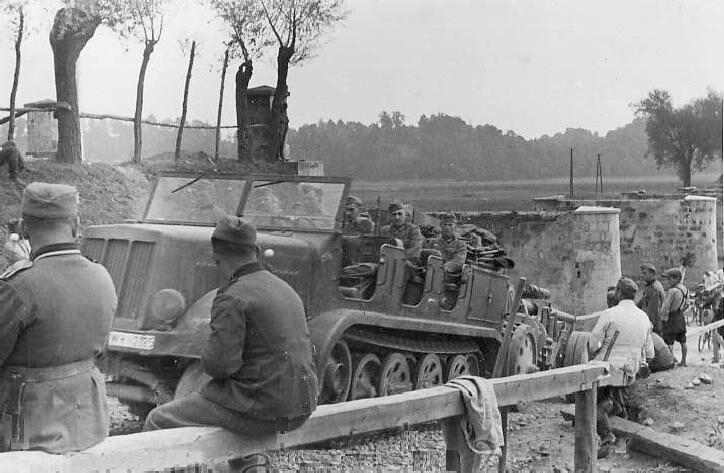
Wehrmacht Organization: Specialized Units

Figure 1.-- Here is a motorized German artillery vehicle. Notice the gun crew in the vehicle.
What was not well understood at the time that the Germany Army was sweeping through France was that the Wehrmacht was not a fully motorized force. The Germany artillery in paticular still relieved heavily on horsepower.
|
|
The Wehrmacht itself had a variety of specialized units. Some of the best known were infantry, panzer (armoured), artillery, paratroop, police, ski, and other units. The infantry and artillery were units that have long existed in European armies. Tanks had appeared on the European battlefield during World War I. It was theBritish who created the tank and used it successfully. German tanks were a disaster. It was the Germans and Soviets that focused in tanks in the inter-War period. And Hitler gave a priority to tanks as he remilitarized Germany. The new German Panzer divisions would play a key role in the German successes in the early campaigns. Paratoops were a German creation. They played a small role in the German Western Offence (1940). Their most important deployment was in Crete and losses were so high that Hitler never employed them again in an aerial capacity. Their major role was to so impress the Allies, that both American and Britain formed paratroop units that did plsy a major role in the war. After World War I, the Reichwehr disbanded military police units. This was primarily because of the limitations established by the Versailles Treaty. Reichwehr commanders did not want to expend limited resources on police units. Thus the Wehrmacht did not at have military police units.
Infantry
The infantry since time imemorial has been the core of any important army. And since the days of the Great Elector (17th century), the Prussian Infantry has been the best trined amd most effective infantry force in the world. (The one exception was a brief period during the eaarly phase of the Napoleonic Wars.)
It is no accident of history that the Prussian infantry, although batter by the French the day before, appeared on the battlefield of Waterloo to support wellington and defeat Napoleon (1815). The one weakness of the Prussian infantry was that is was based on a realitive small state of hymble resources. This changed with the unification of Germany (1871). Imperial Germany was Europe's largest (after Russia) country backed by the most heavily industrialized countru in Europe. This meant that Germany could ammass a huge infantry force which at ythe onset of World War I was not only large and superbly equipped, but led by a officer corps steped in Prussian traditions of aggressive tactics. This was also the core of the Reichwehr that the NAZIs converted into the Wehrmacht.
Artillery
What was not well understood at the time was that the Wehrmacht was not a fully motorized force. The artillery in paticular still relieved heavily on horsepower.
Panzer (Armored)
Tanks had appeared on the European battlefield during World War I. It was theBritish who created the tank and used it successfully. German tanks were a disaster. It was the Germans and Soviets that focused in tanks in the inter-War period. And Hitler gave a priority to tanks as he remilitarized Germany. The new German Panzer divisions would play a key role in the German successes in the early campaigns.
Paratroop
Paratoops were a German creation. They played a small role in the German Western Offence (1940). The German paratroop divisions were some of the best trained and motivated troops in the Wehrmacht. Their most important deployment was in Crete and losses were so high that Hitler never employed them again in an aerial capacity. They were extremely well-trained units and thus served effectively as infantry units. There were, however, no more aerial attacks. Military historians commonly believe that they were used on the wring island. Malta would have been a much more strategic target. Their major role was to so impress the Allies, that both American and Britain formed paratroop units that did play a major role in the war.
After World War I, the Reichwehr disbanded military police units. This was primarily because of the limitations established by the Versailles Treaty. Reichwehr commanders did not want to expend limited resources on police units. Thus the Wehrmacht did not at have military police units.
Garrisons were patrolled by regular soldiers rather than military police units. When the War began, however, the Wehrmacht began forming specialized police units. This was in part a function of the basic military need for dedicayted police units. Other factors pushed the NAZIs to organize a range of police units, including 1) the NAZI's exploitation of occupied countries, 2) NAZI racial policies, and 3) the resistance that developed to German occupation, especually in the Balkans and in the East. As a result, the Germans formed a range of police units, somewithin the Wehrmacht structure, others within the SS.
Abwehr
Quartermaster
If there has been one weakness in Germany armies over time, it was the quartermaster corps. Prussian armies since the day of the Great Elector were based on a small, but highly trained professional core. Because of Prussian's limited resources, German monarchs planned short campaigns that could be won by Prussia;s professiinal standing army before the resources of the larger, richer adversaries could be brought to bear in a long war of attrition. As a result, the quatermaster corps was an organization that was often neglected in German military history.
Signals
HBC

Navigate the Boys' Historical Clothing Web Site:
[Return to Main Wehrmacht organization page]
[Return to Main Wehrmacht page]
[Return to Main NAZI German military force page]
[Return to Main military force page]
[Introduction]
[Activities]
[Biographies]
[Chronology]
[Clothing styles]
[Countries]
[Bibliographies]
[Contributions]
[FAQs]
[Glossaries]
[Images]
[Links]
[Registration]
[Tools]
[Boys' Hitorical Clothing home
Created: 12:17 AM 6/23/2008
Last updated: 12:17 AM 6/23/2008



